RENAULT SCENIC 2008 J84 / 2.G Engine Compartment Connection Unit Workshop Manual
Manufacturer: RENAULT, Model Year: 2008, Model line: SCENIC, Model: RENAULT SCENIC 2008 J84 / 2.GPages: 94, PDF Size: 0.28 MB
Page 1 of 94
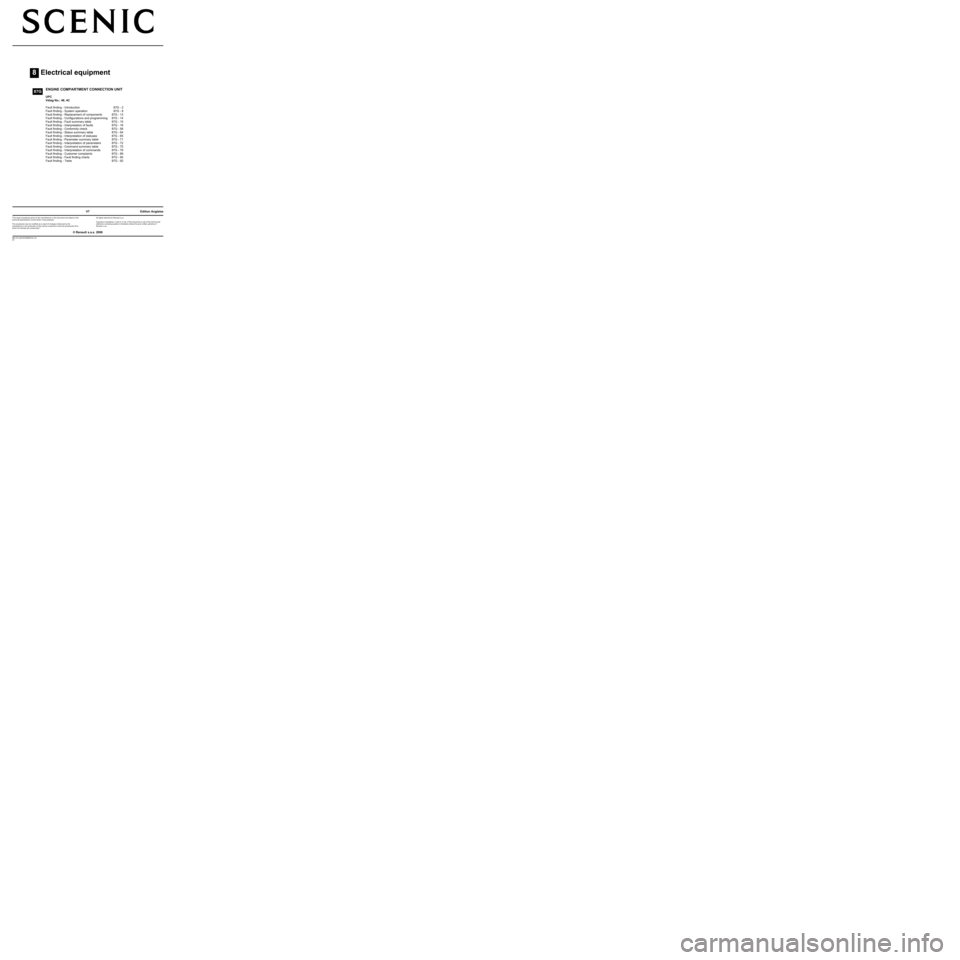
8Electrical equipment
V7 MR-372-J84-87G050$TOC.mif
V7
87G
"The repair procedures given by the manufacturer in this document are based on the
technical specifications current when it was prepared.
The procedures may be modified as a result of changes introduced by the
manufacturer in the production of the various component units and accessories from
which his vehicles are constructed."
V7
All rights reserved by Renault s.a.s.
Edition Anglaise
Copying or translating, in part or in full, of this document or use of the service part
reference numbering system is forbidden without the prior written authority of
Renault s.a.s.
© Renault s.a.s. 2008
ENGINE COMPARTMENT CONNECTION UNIT
UPC
Vdiag No.: 48, 4C
Fault finding - Introduction 87G - 2
Fault finding - System operation 87G - 8
Fault finding - Replacement of components 87G - 13
Fault finding - Configurations and programming 87G - 14
Fault finding - Fault summary table 87G - 15
Fault finding - Interpretation of faults 87G - 16
Fault finding - Conformity check 87G - 56
Fault finding - Status summary table 87G - 64
Fault finding - Interpretation of statuses 87G - 65
Fault finding - Parameter summary table 87G - 71
Fault finding - Interpretation of parameters 87G - 72
Fault finding - Command summary table 87G - 75
Fault finding - Interpretation of commands 87G - 76
Fault finding - Customer complaints 87G - 89
Fault finding - Fault finding charts 87G - 90
Fault finding - Tests 87G - 92
Page 2 of 94
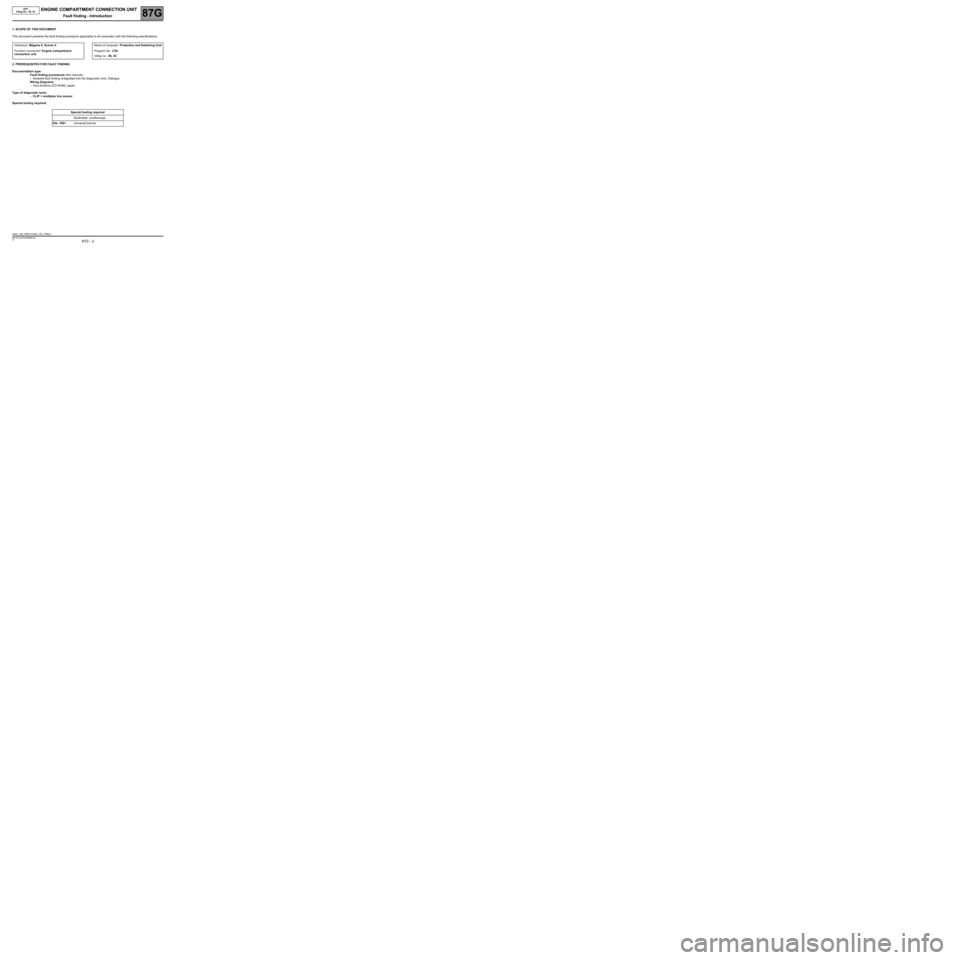
ENGINE COMPARTMENT CONNECTION UNIT
Fault finding - Introduction87G
87G - 2V7 MR-372-J84-87G050$055.mif
187G
UPC
Vdiag No.: 48, 4C ENGINE COMPARTMENT CONNECTION UNIT
Fault finding - Introduction
1. SCOPE OF THIS DOCUMENT
This document presents the fault finding procedure applicable to all computers with the following specifications:
2. PREREQUISITES FOR FAULT FINDING
Documentation type:
Fault finding procedures (this manual):
–Assisted fault finding (integrated into the diagnostic tool), Dialogys.
Wiring Diagrams:
–Visu-Schéma (CD-ROM), paper.
Type of diagnostic tools:
–CLIP + multiplex line sensor
Special tooling required:Vehicle(s): Mégane II, Scenic II
Function concerned: Engine compartment
connection unitName of computer: Protection and Switching Unit
Program No.: C54
Vdiag no.: 48, 4C
Special tooling required
Multimeter, oscilloscope
Elé. 1681Universal bornier
USM_V48_PRELI/USM_V4C_PRELI
MR-372-J84-87G050$055.mif
Page 3 of 94
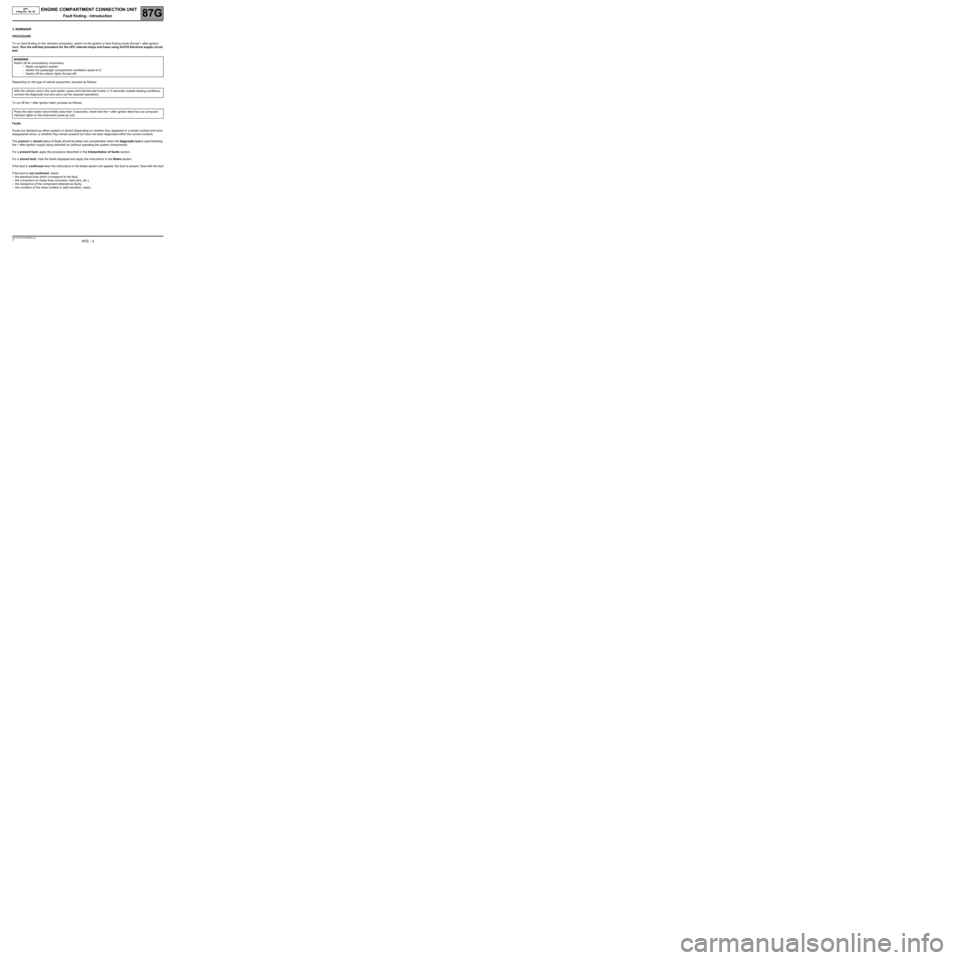
ENGINE COMPARTMENT CONNECTION UNIT
Fault finding - Introduction87G
87G - 3V7 MR-372-J84-87G050$055.mif
UPC
Vdiag No.: 48, 4C
3. REMINDER
PROCEDURE
To run fault finding on the vehicle's computers, switch on the ignition in fault finding mode (forced + after ignition
feed). Run the self-test procedure for the UPC internal relays and fuses using AC016 Electrical supply circuit
test.
Depending on the type of vehicle equipment, proceed as follows:
To cut off the + after ignition feed, proceed as follows:
Faults
Faults are declared as either present or stored (depending on whether they appeared in a certain context and have
disappeared since, or whether they remain present but have not been diagnosed within the current context).
The present or stored status of faults should be taken into consideration when the diagnostic tool is used following
the + after ignition supply being switched on (without operating the system components).
For a present fault, apply the procedure described in the Interpretation of faults section.
For a stored fault, note the faults displayed and apply the instructions in the Notes section.
If the fault is confirmed when the instructions in the Notes section are applied, the fault is present. Deal with the fault
If the fault is not confirmed, check:
–the electrical lines which correspond to the fault,
–the connectors on these lines (corrosion, bent pins, etc.),
–the resistance of the component detected as faulty,
–the condition of the wires (melted or split insulation, wear). WARNING
Switch off all unnecessary consumers:
–Radio navigation system.
–Switch the passenger compartment ventilation speed to 0.
–Switch off the interior lights (forced off).
With the vehicle card in the card reader, press and hold the start button (+ 5 seconds) outside starting conditions,
connect the diagnostic tool and carry out the required operations.
Press the start button twice briefly (less than 3 seconds); check that the + after ignition feed has cut (computer
indicator lights on the instrument panel go out).
Page 4 of 94
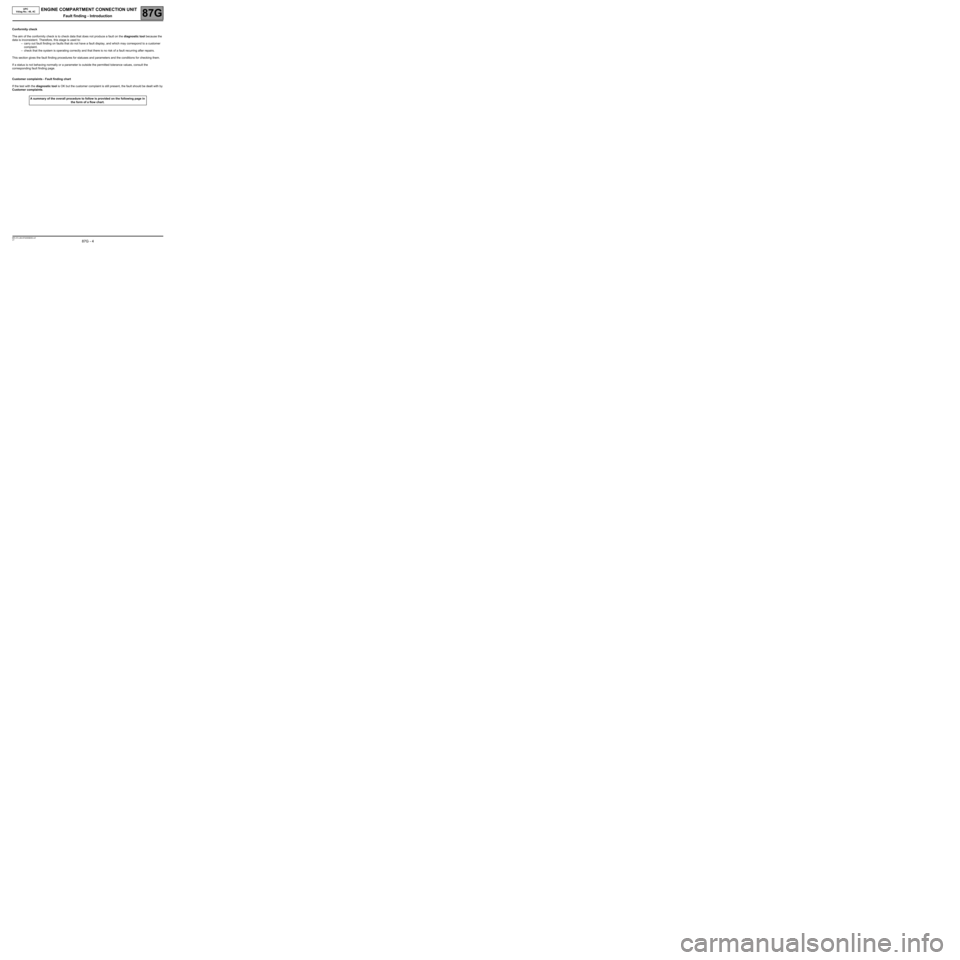
ENGINE COMPARTMENT CONNECTION UNIT
Fault finding - Introduction87G
87G - 4V7 MR-372-J84-87G050$055.mif
UPC
Vdiag No.: 48, 4C
Conformity check
The aim of the conformity check is to check data that does not produce a fault on the diagnostic tool because the
data is inconsistent. Therefore, this stage is used to:
–carry out fault finding on faults that do not have a fault display, and which may correspond to a customer
complaint.
–check that the system is operating correctly and that there is no risk of a fault recurring after repairs.
This section gives the fault finding procedures for statuses and parameters and the conditions for checking them.
If a status is not behaving normally or a parameter is outside the permitted tolerance values, consult the
corresponding fault finding page.
Customer complaints - Fault finding chart
If the test with the diagnostic tool is OK but the customer complaint is still present, the fault should be dealt with by
Customer complaints.
A summary of the overall procedure to follow is provided on the following page in
the form of a flow chart.
Page 5 of 94
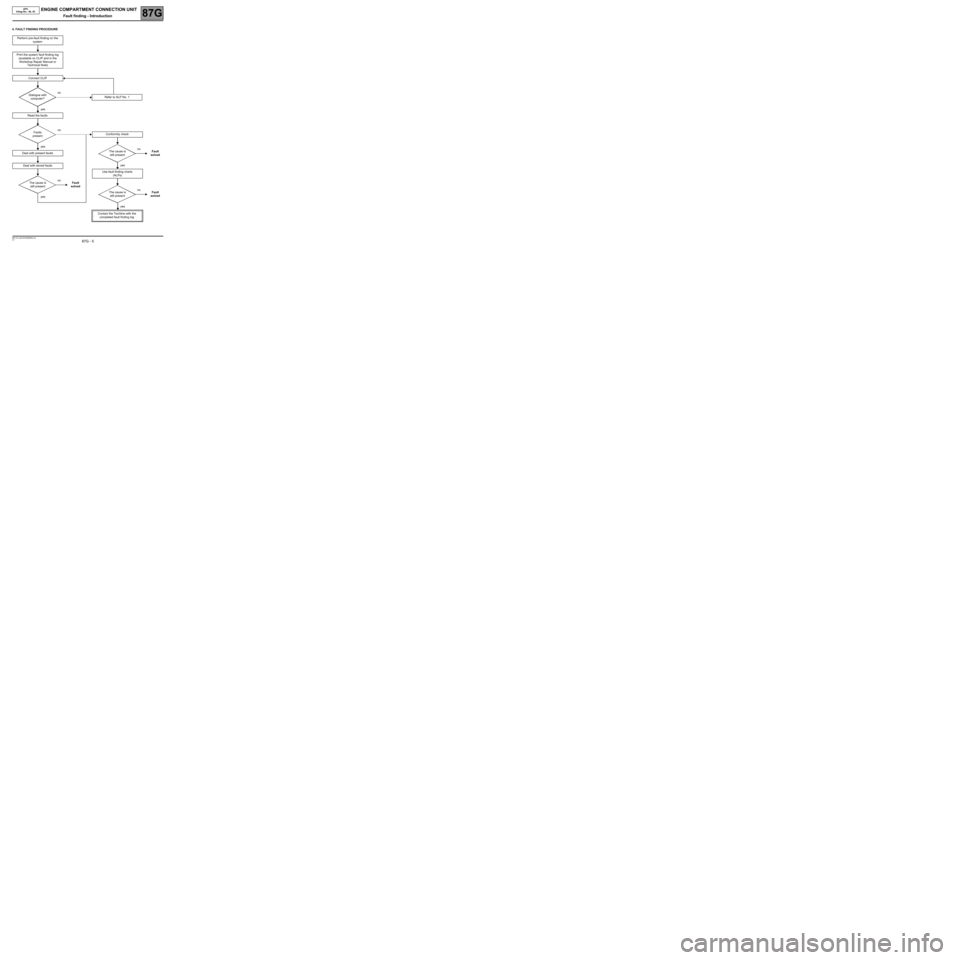
ENGINE COMPARTMENT CONNECTION UNIT
Fault finding - Introduction87G
87G - 5V7 MR-372-J84-87G050$055.mif
UPC
Vdiag No.: 48, 4C
4. FAULT FINDING PROCEDURE
Perform pre-fault finding on the
system
Print the system fault finding log
(available on CLIP and in the
Workshop Repair Manual or
Technical Note)
Connect CLIP
no
Dialogue with
computer?
yes
Read the faults
no
Faults
present
yes
Deal with present faults
Deal with stored faults
no
The cause is
still presentFault
solved
yes
Refer to ALP No. 1
Conformity check
no
The cause is
still presentFault
solved
yes
Use fault finding charts
(ALPs)
no
The cause is
still presentFault
solved
yes
Contact the Techline with the
completed fault finding log
Page 6 of 94
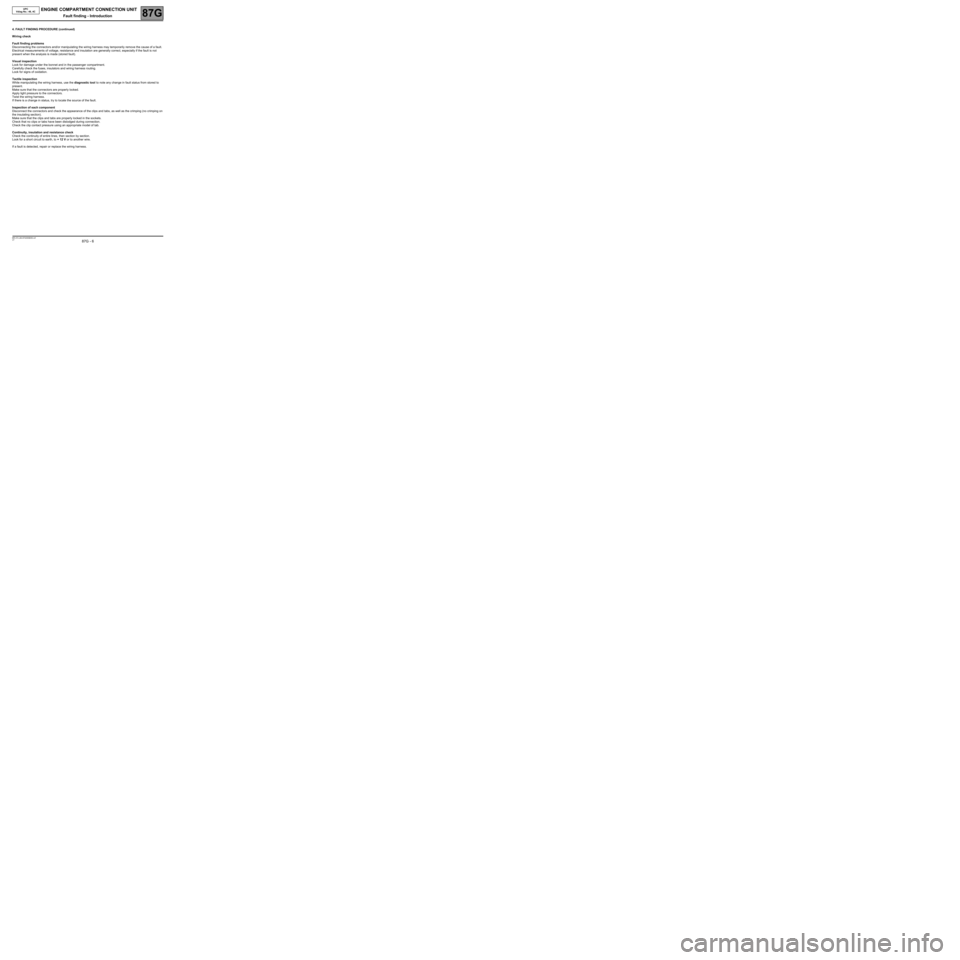
ENGINE COMPARTMENT CONNECTION UNIT
Fault finding - Introduction87G
87G - 6V7 MR-372-J84-87G050$055.mif
UPC
Vdiag No.: 48, 4C
4. FAULT FINDING PROCEDURE (continued)
Wiring check
Fault finding problems
Disconnecting the connectors and/or manipulating the wiring harness may temporarily remove the cause of a fault.
Electrical measurements of voltage, resistance and insulation are generally correct, especially if the fault is not
present when the analysis is made (stored fault).
Visual inspection
Look for damage under the bonnet and in the passenger compartment.
Carefully check the fuses, insulators and wiring harness routing.
Look for signs of oxidation.
Tactile inspection
While manipulating the wiring harness, use the diagnostic tool to note any change in fault status from stored to
present.
Make sure that the connectors are properly locked.
Apply light pressure to the connectors.
Twist the wiring harness.
If there is a change in status, try to locate the source of the fault.
Inspection of each component
Disconnect the connectors and check the appearance of the clips and tabs, as well as the crimping (no crimping on
the insulating section).
Make sure that the clips and tabs are properly locked in the sockets.
Check that no clips or tabs have been dislodged during connection.
Check the clip contact pressure using an appropriate model of tab.
Continuity, insulation and resistance check
Check the continuity of entire lines, then section by section.
Look for a short circuit to earth, to + 12 V or to another wire.
If a fault is detected, repair or replace the wiring harness.
Page 7 of 94
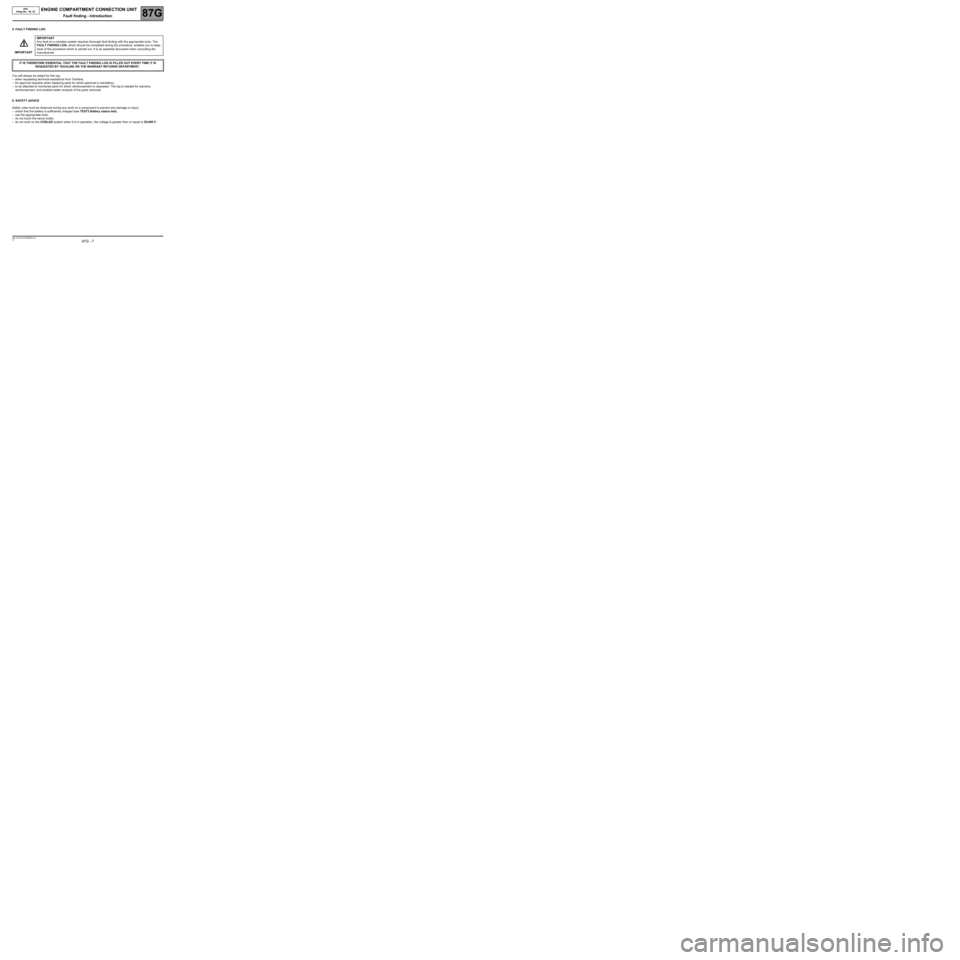
ENGINE COMPARTMENT CONNECTION UNIT
Fault finding - Introduction87G
87G - 7V7 MR-372-J84-87G050$055.mif
UPC
Vdiag No.: 48, 4C
5. FAULT FINDING LOG
You will always be asked for this log:
–when requesting technical assistance from Techline,
–for approval requests when replacing parts for which approval is mandatory,
–to be attached to monitored parts for which reimbursement is requested. The log is needed for warranty
reimbursement, and enables better analysis of the parts removed.
6. SAFETY ADVICE
Safety rules must be observed during any work on a component to prevent any damage or injury:
–check that the battery is sufficiently charged (see TEST3 Battery status test),
–use the appropriate tools,
–do not touch the xenon bulbs.
–do not work on the COSLAD system when it is in operation, the voltage is greater than or equal to 20,000 V. IMPORTANT IMPORTANT
Any fault on a complex system requires thorough fault finding with the appropriate tools. The
FAULT FINDING LOG, which should be completed during the procedure, enables you to keep
track of the procedure which is carried out. It is an essential document when consulting the
manufacturer.
IT IS THEREFORE ESSENTIAL THAT THE FAULT FINDING LOG IS FILLED OUT EVERY TIME IT IS
REQUESTED BY TECHLINE OR THE WARRANT RETURNS DEPARTMENT.
Page 8 of 94
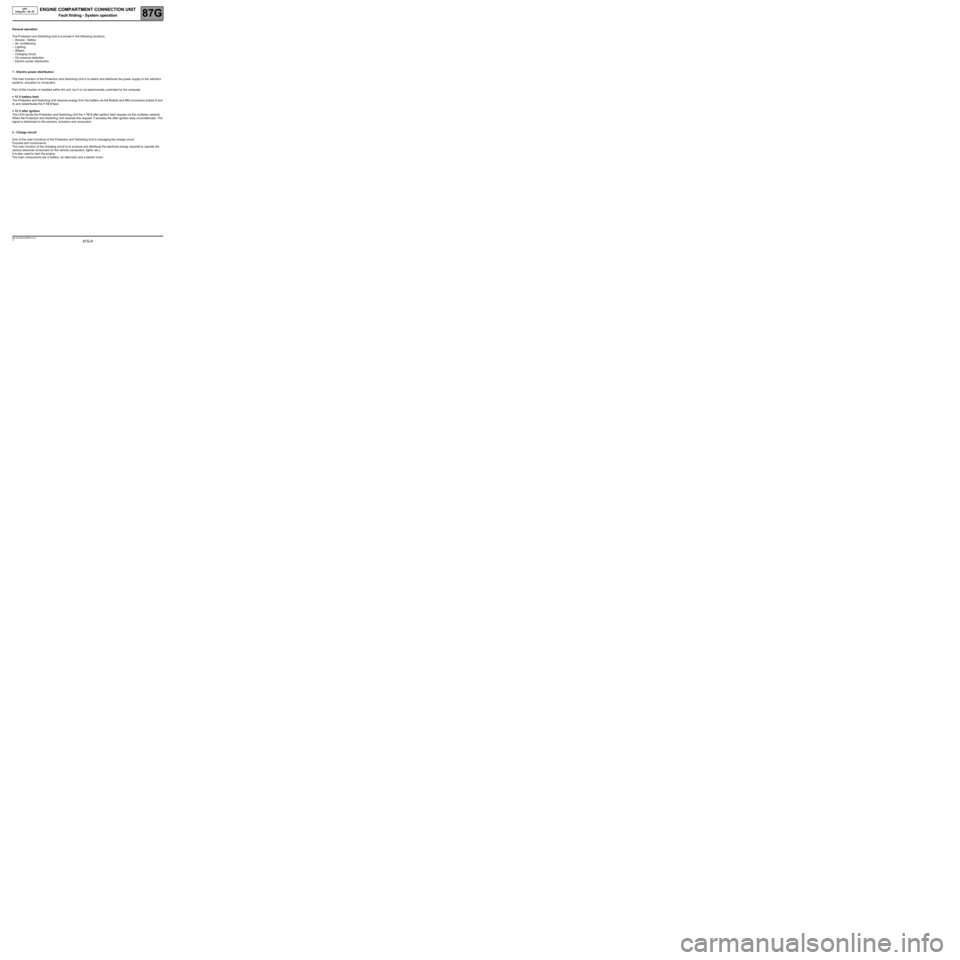
ENGINE COMPARTMENT CONNECTION UNIT
Fault finding - System operation87G
87G-8V7 MR-372-J84-87G050$110.mif
UPC
Vdiag No.: 48, 4CENGINE COMPARTMENT CONNECTION UNIT
Fault finding - System operation
General operation
The Protection and Switching Unit is involved in the following functions:
–Access - Safety.
–Air conditioning.
–Lighting.
–Wipers.
–Charging circuit.
–Oil pressure detection.
–Electric power distribution.
1 - Electric power distribution
The main function of the Protection and Switching Unit is to switch and distribute the power supply to the vehicle's
systems, actuators or computers.
Part of this function is handled within the unit, but it is not electronically controlled by the computer.
+ 12 V battery feed
The Protection and Switching Unit receives energy from the battery via the Busbar and MM connectors (tracks 6 and
4) and redistributes the + 12 V feed.
+ 12 V after ignition
The UCH sends the Protection and Switching Unit the + 12 V after ignition feed request via the multiplex network.
When the Protection and Switching Unit receives this request, it actuates the after ignition relay unconditionally. The
signal is distributed to the sensors, actuators and computers.
2 - Charge circuit
One of the main functions of the Protection and Switching Unit is managing the charge circuit.
Purpose and components:
The main function of the charging circuit is to produce and distribute the electrical energy required to operate the
various electrical consumers on the vehicle (computers, lights, etc.).
It is also used to start the engine.
The main components are a battery, an alternator and a starter motor.
MR-372-J84-87G050$110.mif
Page 9 of 94
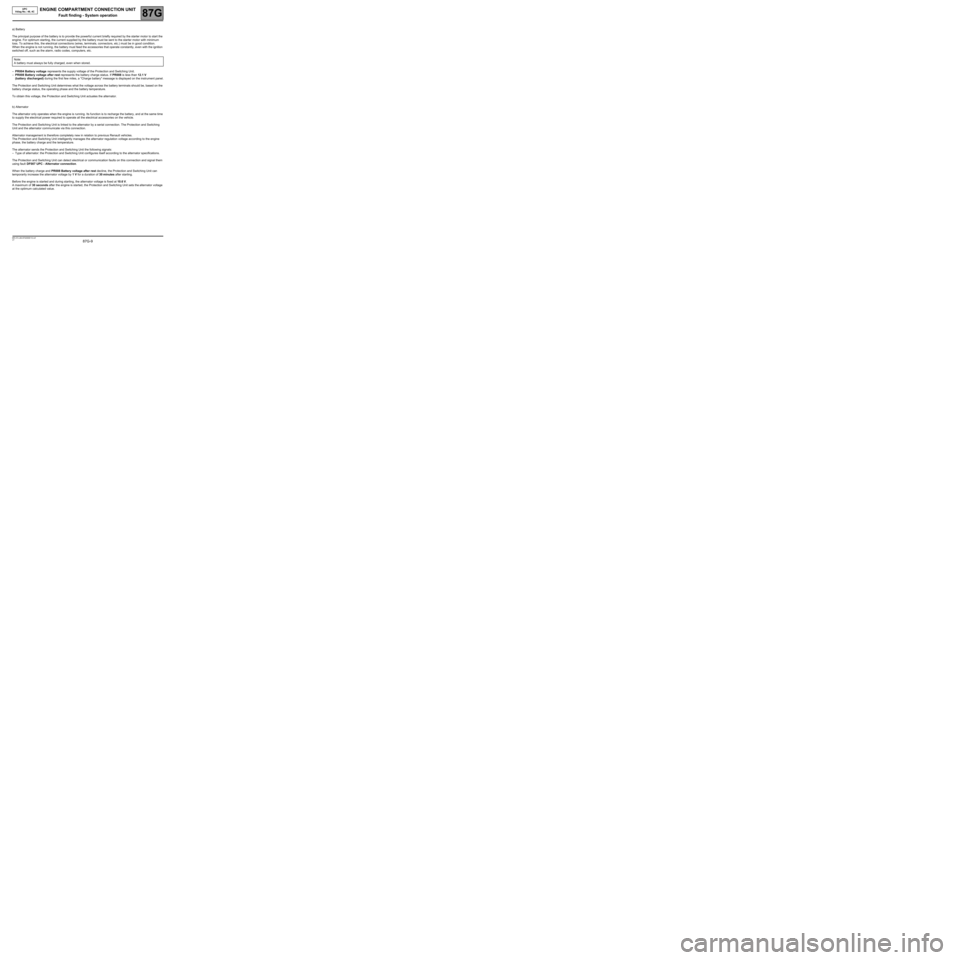
ENGINE COMPARTMENT CONNECTION UNIT
Fault finding - System operation87G
87G-9V7 MR-372-J84-87G050$110.mif
UPC
Vdiag No.: 48, 4C
a) Battery
The principal purpose of the battery is to provide the powerful current briefly required by the starter motor to start the
engine. For optimum starting, the current supplied by the battery must be sent to the starter motor with minimum
loss. To achieve this, the electrical connections (wires, terminals, connectors, etc.) must be in good condition.
When the engine is not running, the battery must feed the accessories that operate constantly, even with the ignition
switched off, such as the alarm, radio codes, computers, etc.
–PR004 Battery voltage represents the supply voltage of the Protection and Switching Unit.
–PR008 Battery voltage after rest represents the battery charge status. If PR008 is less than 12.1 V
(battery discharged) during the first few miles, a "Charge battery" message is displayed on the instrument panel.
The Protection and Switching Unit determines what the voltage across the battery terminals should be, based on the
battery charge status, the operating phase and the battery temperature.
To obtain this voltage, the Protection and Switching Unit actuates the alternator.
b) Alternator
The alternator only operates when the engine is running. Its function is to recharge the battery, and at the same time
to supply the electrical power required to operate all the electrical accessories on the vehicle.
The Protection and Switching Unit is linked to the alternator by a serial connection. The Protection and Switching
Unit and the alternator communicate via this connection.
Alternator management is therefore completely new in relation to previous Renault vehicles.
The Protection and Switching Unit intelligently manages the alternator regulation voltage according to the engine
phase, the battery charge and the temperature.
The alternator sends the Protection and Switching Unit the following signals:
–Type of alternator: the Protection and Switching Unit configures itself according to the alternator specifications.
The Protection and Switching Unit can detect electrical or communication faults on this connection and signal them
using fault DF007 UPC - Alternator connection.
When the battery charge and PR008 Battery voltage after rest decline, the Protection and Switching Unit can
temporarily increase the alternator voltage by 1 V for a duration of 30 minutes after starting.
Before the engine is started and during starting, the alternator voltage is fixed at 10.6 V.
A maximum of 30 seconds after the engine is started, the Protection and Switching Unit sets the alternator voltage
at the optimum calculated value.Note:
A battery must always be fully charged, even when stored.
Page 10 of 94
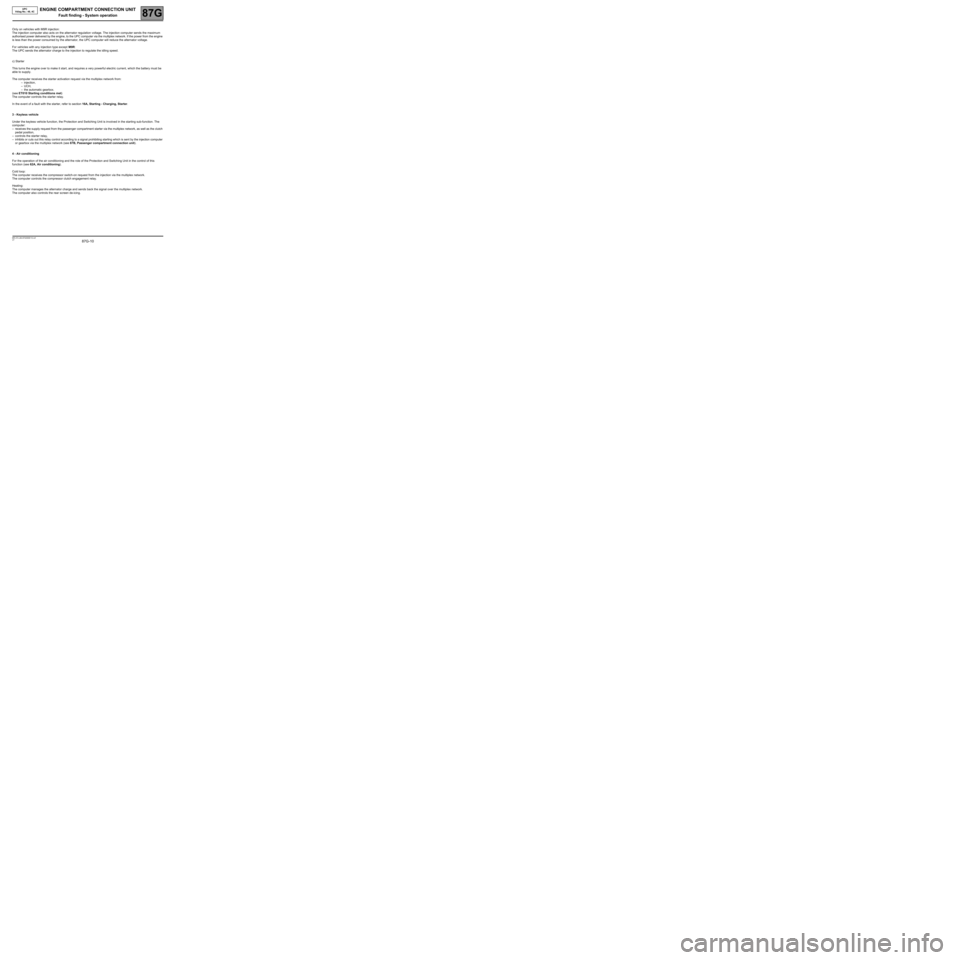
ENGINE COMPARTMENT CONNECTION UNIT
Fault finding - System operation87G
87G-10V7 MR-372-J84-87G050$110.mif
UPC
Vdiag No.: 48, 4C
Only on vehicles with M9R injection:
The injection computer also acts on the alternator regulation voltage. The injection computer sends the maximum
authorised power delivered by the engine, to the UPC computer via the multiplex network. If the power from the engine
is less than the power consumed by the alternator, the UPC computer will reduce the alternator voltage.
For vehicles with any injection type except M9R:
The UPC sends the alternator charge to the injection to regulate the idling speed.
c) Starter
This turns the engine over to make it start, and requires a very powerful electric current, which the battery must be
able to supply.
The computer receives the starter activation request via the multiplex network from:
–injection,
–UCH,
–the automatic gearbox.
(see ET010 Starting conditions met)
The computer controls the starter relay.
In the event of a fault with the starter, refer to section 16A, Starting - Charging, Starter.
3 - Keyless vehicle
Under the keyless vehicle function, the Protection and Switching Unit is involved in the starting sub-function. The
computer:
–receives the supply request from the passenger compartment starter via the multiplex network, as well as the clutch
pedal position,
–controls the starter relay,
–inhibits or cuts out this relay control according to a signal prohibiting starting which is sent by the injection computer
or gearbox via the multiplex network (see 87B, Passenger compartment connection unit).
4 - Air conditioning
For the operation of the air conditioning and the role of the Protection and Switching Unit in the control of this
function (see 62A, Air conditioning).
Cold loop:
The computer receives the compressor switch-on request from the injection via the multiplex network.
The computer controls the compressor clutch engagement relay.
Heating:
The computer manages the alternator charge and sends back the signal over the multiplex network.
The computer also controls the rear screen de-icing.